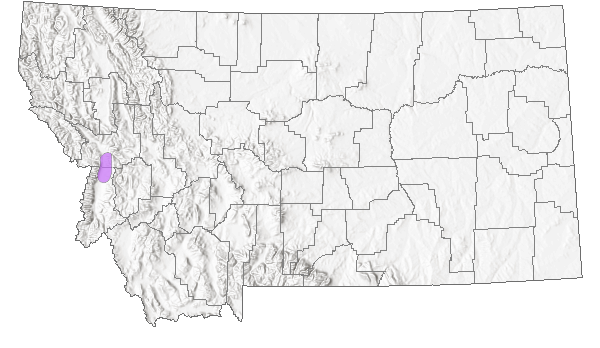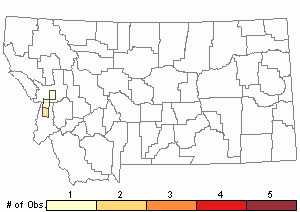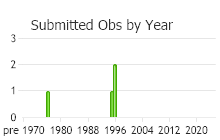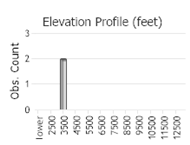View in other NatureServe Network Field Guides
NatureServe
Montana
Utah
Wyoming
Idaho
Wisconsin
British Columbia
South Carolina
Yukon
California
New York
Bartram's Syntrichia Moss - Syntrichia bartramii
Other Names:
Bartram's Twist Moss,
Tortula bartramii
State Rank Reason (see State Rank above)
Tortula species with leaves turning red in 2% KOH solution, among other characteristics, have been placed in Henediella, Microbryum, or Syntrichia. Reduction in sporophyte development, such as capsule and peristome development, is prominent in Tortula but for which there is little evidence in Syntrichia (FNA 2007).
General Description
Plants: Acrocarpous. Typically in small clumps of erect shoots, chartreuse to deep russet. Stems 5-15 mm tall, occasionally forked, and lacking a central strand (Lawton 1971).
Leaves: Folded inwards and twisted around the stem when dry, 1.25-2 mm in length, 0.5-0.75 mm in width, broadly spreading when wet, tongue- or spatula-shaped; margins smooth and flat (FNA 2007) or barely curved downwards below (Lawton 1971), with papillae creating minute undulations; border absent; apex truncate (FNA 2007), obtuse or broadly acute (Lawton 1971), sometimes notched; costa with few to many tiny sharp spines on the lower surface, and extending beyond the apex to form a narrowing awn; awn hyaline or red, 0.1-0.6 mm in length (FNA 2007).
Leaf Cells: Apical leaf cells about as long as broad with thick walls and densely covered with papillae; basal cells distinguished from those above, the transversely-directed walls thickened, the cells toward the margins not as broad and not thickened in the corners (FNA 2007); costa X-section reveals an abaxial stereid band and 2-4 guide cells (Lawton 1971).
Diagnostic Characteristics
The narrowing, toothed costal awn and the flat leaf margins are key characteristics (FNA 2007).
Species Range
Montana Range
Range Descriptions

 Native
Native
Range Comments
Mexico: Baja California, and to be expected in Sonora and Chihuahua; United States: California, Arizona, New Mexico, Texas, Colorado and Idaho (Sharp et al. 1994). Known in Montana from Missoula and Ravalli Counties (Elliott 2016).
Observations in Montana Natural Heritage Program Database
Number of Observations: 4
(Click on the following maps and charts to see full sized version)
Map Help and Descriptions
Relative Density

Recency



 (Observations spanning multiple months or years are excluded from time charts)
(Observations spanning multiple months or years are excluded from time charts)
Habitat
Dry soil and rock, including soil derived from volcanic ash (Elliott 2016). Elevation: 2400-7875 feet or higher (Lawton 1971).
Reproductive Characteristics
Probably dioicous; neither perigonia nor sporophytes have been seen (FNA 2007; Lawton 1971).
Specialized vegetative reproduction absent (FNA 2007).
Stewardship Responsibility
References
- Literature Cited AboveLegend:
 View Online Publication
View Online Publication Elliott, J.C. and A.K. Pipp. 2018. A Checklist of Montana Mosses (1880-2018). Updated 3 January, 2020. Montana Natural Heritage Program, Helena, Montana. 73 pp.
Elliott, J.C. and A.K. Pipp. 2018. A Checklist of Montana Mosses (1880-2018). Updated 3 January, 2020. Montana Natural Heritage Program, Helena, Montana. 73 pp. Flora of North America Editorial Committee, eds. 2007. Flora of North America North of Mexico. Volume 27. Bryophytes: Mosses, Part 1. Oxford University Press, Inc., NY. xxi + 713 pp.
Flora of North America Editorial Committee, eds. 2007. Flora of North America North of Mexico. Volume 27. Bryophytes: Mosses, Part 1. Oxford University Press, Inc., NY. xxi + 713 pp. Lawton, E. 1971. Moss Flora of the Pacific Northwest. Hattori Botanical Laboratory. Japan: Yamabuki-cho, Shinjuku-ku, Tokyo. 362 pages plus appendices.
Lawton, E. 1971. Moss Flora of the Pacific Northwest. Hattori Botanical Laboratory. Japan: Yamabuki-cho, Shinjuku-ku, Tokyo. 362 pages plus appendices. Sharp, A. J., H. A. Crum, and P. M. Eckel. 1994. The Moss Flora of Mexico. Memoirs of the New York Botanical Garden, Volume 69. Bronx, NY: New York Botanical Garden. 2 volumes, viii + 1113 pp.
Sharp, A. J., H. A. Crum, and P. M. Eckel. 1994. The Moss Flora of Mexico. Memoirs of the New York Botanical Garden, Volume 69. Bronx, NY: New York Botanical Garden. 2 volumes, viii + 1113 pp.
- Additional ReferencesLegend:
 View Online Publication
View Online Publication
Do you know of a citation we're missing? Elliot, J. C. 1993. Second checklist of Montana mosses. Unpublished report. U.S. Forest Service, Region 1. Missoula, MT. 45 pp.
Elliot, J. C. 1993. Second checklist of Montana mosses. Unpublished report. U.S. Forest Service, Region 1. Missoula, MT. 45 pp. Lawton, E. 1971. Keys for the Identification of the Mosses on the Pacific Northwest. Reprinted from 'Moss Flora of the Pacific Northwest'. Published as Supplement No. 2 of the Journal of the Hattori Botanical Laboratory. Nichinan, Miyazaki, Japan. 66 pp.
Lawton, E. 1971. Keys for the Identification of the Mosses on the Pacific Northwest. Reprinted from 'Moss Flora of the Pacific Northwest'. Published as Supplement No. 2 of the Journal of the Hattori Botanical Laboratory. Nichinan, Miyazaki, Japan. 66 pp.
- Web Search Engines for Articles on "Bartram's Syntrichia Moss"





